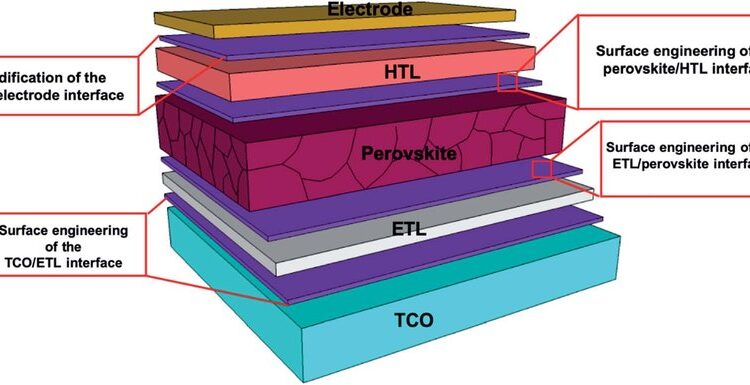Perovskite Solar Cell : the research of perovskite thin film materials is in full swing. Recently, Professor Chang Jingjing’s team of Academician Hao Yue’an University of Electronic Science and Technology has been doped by using fluorinated molecules (CF3-PEABr) interface passivation of perovskite thin film co-surfactants (Triton X-100). Modified PC61BM realizes high-efficiency and stable perovskite solar cell devices.
Perovskite Solar Cell Related research with “Synergistic Interface Layer Optimization and Surface Passivation with Fluorocarbon Molecules” “The title of towards Efficient and Stable Inverted Planar Perovskite Solar Cells” published in Research.
Organic-inorganic hybrid perovskite materials have shown great potential in solar cells, light-emitting diodes, photoelectric detection, resistance memory and other fields due to their strong light absorption rate, high mobility, long carrier life, adjustable band gap and various processing methods.
Especially in the field of solar cells, the energy conversion efficiency of solar cells based on organic-inorganic perovskite materials has increased from 3.8% to 25.5% since it was first reported in 2009.
However, due to the existence of organic ions (MA+, FA+, etc.), the stability of organic ions has always been the focus of the commercial development of photovoltaic devices.
How to improve the stability of perovskite thin film materials while maintaining excellent photoelectric properties is a key technical problem to be solved urgently.
Professor Chang Jingjing’s research group of Academician Hao Yue of Xi’an University of Electronic Science and Technology achieved efficient stabilization of perovskite solar cell devices by using the interface passivation of perovskite thin film co-surfactant (Triton X-100) to modify PC61BM.
The research shows that by using fluoride molecules (CF3-PEABr) to modify the perovskite interface to form low-dimensional perovskite, the interface defect state can be effectively passivated and the crystalline quality of the film can be improved.
At the same time, trifluoromethyl groups are self-assembled and aggregated on the surface of perovskite films, which enhances the hydrophobic characteristics of perovskite films, alleviates the erosion of perovskite films by water and oxygen, and improves the stability of Perovskite Solar Cell (Figure 1).

Based on density functional theory, the state density, defect formation energy and ion migration energy of different defect structures are calculated, and the influence of CF3-PEABr passivation on the microphysical characteristics of perovskite is studied and analyzed (Figure 2).

Although the hydrophobic properties of the trifluoromethyl group can improve the stability of the film, it also leads to discontinuity of the PC61BM electron transport layer on the perovskite layer, affecting the performance of the device.
This work innovatively introduces the surfactant Triton X-100 doped modified PC61BM, thus realizing the preparation of continuous electron transport layers on the surface of hydrophobic perovskite.
At the same time, because surfactants contain hydrophobic long chains and hydrophilic groups respectively, the hydroxyl group at the end can be in contact with trifluoromethyl on the surface of perovskite film through hydrogen bonding or electrostatic action to achieve effective charge transmission and extraction, thus realizing high-performance perovskite solar cell devices.
In addition, the self-assembly of surfactant hydrophobic groups in the PC61BM layer enhances the hydrophobic characteristics of the PC61BM layer and improves the film stability of the electron transport layer.
Based on the doping modification of fluorinated molecules (CF3-PEABr) interface passivation co-surfactant (Triton X-100), the study achieved 21.9% device efficiency and 1.15V high open-circuit voltage based on trans perovskite battery devices, while showing good performance. Device light stability, thermal stability and long-term stability.
When the device is placed in air (humidity ~35%) for 1,000 hours, its device performance can still maintain 98% of the initial efficiency. Compared with the Control device, its device stability and thin film stability have been significantly improved (Figure 3).

Future and Prospect
In this study, an effective fluoride passivation strategy is proposed to improve the stability of thin films and devices. At the same time, the surfactant Triton X-100 is introduced to solve the difficult problem of discontinuity of the electron transport layer caused by the hydrophobic interface of perovskite thin films, and realize efficient and stable trans perovskite solar cell devices.
The passivation strategy and surfactant doping in this study have good universality, which provides a new idea for the development of efficiency and stability of trans perovskite devices, which is expected to be applied to the research of fully printed perovskite solar cells.

